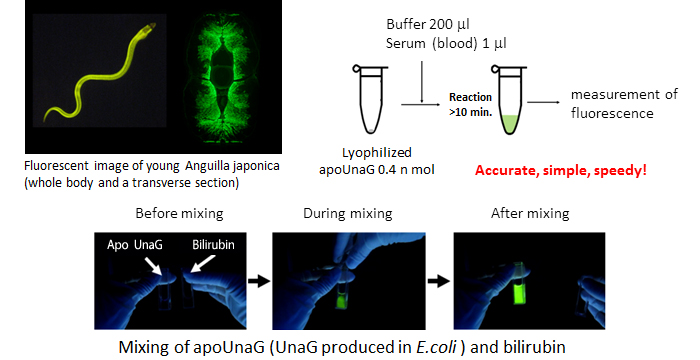Mar. 20, 2014
Fluorescent agent based on fluorescent protein UnaG for clinical assay
RIKEN No.: 08118
Inventors
Atsushi Miyawaki, Akiko Kumagai (Laboratory for Cell Function Dynamics)
Background
Bilirubin is a pigment formed from breakdown of hemoglobin in red blood cells, and one of parameters of blood chemistry analysis for evaluation of hemolysis or liver function. Conventional methods to determine bilirubin level are complicated and less sensitive to bilirubin.
Summary
- We have succeeded in isolation of fluorescent protein gene (UnaG) from Japanese eel (Anguilla japonica), and discovered that fluorescence is emitted by binding bilirubin and UnaG as an apo-protein produced in E. coli. Based on this phenomenon we also have developed a kit to determine serum bilirubin level (see figure below). Binding between UnaG and bilirubin is so potent that all bilirubin in serum (blood) samples can be detected irrespective of its binding status to albumin.
- Complicated procedures or calculations used in the conventional methods are no longer necessary. Since our method depends on fluorescence, detection sensitivity is markedly improved, and bilirubin level can be determined in smaller amounts of sample. Sensitivity of our method is improved by 3 orders compared to the conventional methods.
- With our method, serum bilirubin can be accurately determined without burden on low-birth-weight babies. Kernicterus can be detected and prevented in a simple manner.
- This simple and rapid quantification of bilirubin will be beneficial for newborns in developing countries or remote regions.

Expected applications
- New test procedures to quantify bilirubin rapidly and accurately with high sensitivity.
- Fluorescent imaging under hypoxic or anoxic condition (visualization of processes in solid cancer tissue).
References
- 1.PCT/JP20143/055160
More information
- 1.Press Release (June 14, 2013) "New fluorescent protein from eel revolutionizes key clinical assay"
